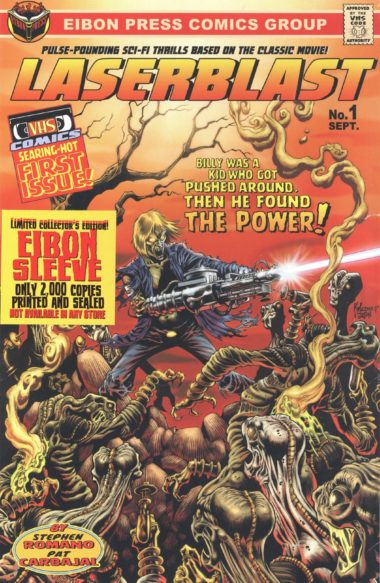 By STEPHEN ROMANO, PAT CARBAJAL (Eibon; 2017)
By STEPHEN ROMANO, PAT CARBAJAL (Eibon; 2017)
Fact: the no-budget Charles Band movie LASERBLAST (1978) sucks. This nearly-40-years-after-the-fact comic book adaptation, however, is somewhat interesting.
This nearly-40-years-after-the-fact comic book adaptation, however, is somewhat interesting.
It’s the first of what was intended as a six issue miniseries, but poor sales resulted in this 26 page intro being the only LASEREBLAST comic. Obviously it’s not entirely satisfying, given that its ending is left unresolved, but LASERBLAST #1 is at least better than the flick, which as scripter Stephen Romano admits in his afterward is not particularly varied or ambitious, with its major selling point being the core concept.
That concept involves a young man getting ahold of a laser gun left by some scatterbrained aliens, and using it to shoot a bunch of people in the California desert. Romano fleshes out the young man, a van driving punk named Billy, as well as the aliens, a band of dinosaur-headed smart-asses, and the gun, which overtakes the brains of its human subjects and is fully capable of spreading its mind-destroying contagion around the world. This is proven by another guy in possession of the weapon, who as the comic opens has already been transformed into a quasi-monster by the gun—thus making this a sequel to as well as a reimagining of the original LASERBLAST.
Unfortunately that’s about all we get plot-wise, a mere taste of what could have been a compelling saga. Romano’s disturbed imagination is operating at full boil, and illustrator Pat Carbajal provides some nifty photorealistic artwork with a spot-on eye for bloodletting and mayhem, which goes well with the slick packaging by the always enterprising Eibon Press. This was the first of Eibon’s “VHS Comics” series, meaning comics inspired by and patterned after horror/exploitation films from the VHS era.
Which brings me to an aspect of this comic I did appreciate: a concluding essay by Joe Fay about the LASERBLAST flick and its effect on the home video market. It was apparently one of the first-ever straight-to-video movies, having been intended for a VHS release (although it played the drive-in circuit) and released through Charles Band’s own company Meda, which became Media Home Entertainment, an important player in the home video market of the 1980s—or as Fay tells it, “Media lived fast and died young, barely fifteen years old, but not before stamping its own inimitable character on the history of home video. And what a good-looking corpse they left behind.”
